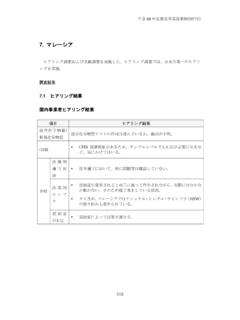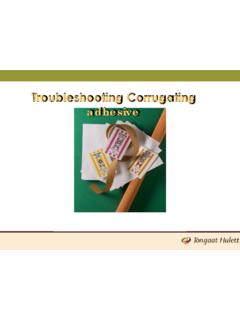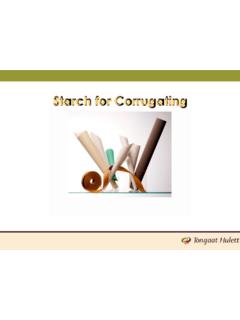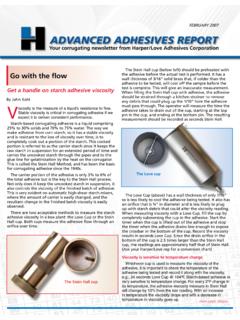Transcription of 24.Corrugated Packaging Industry - nite
1 Packaging Industry 1. Outline of Manufacturing Process and Materials Utilized The manufacture of corrugated Packaging can be roughly classified into two processes: the containerboard combining process, which glues one or more sheets of fluted corrugating medium to one or more flat facings of linerboard;. and the box manufacturing process, which is used to assemble the corrugated sheets into boxes. Figure 1 depicts the typical manufacturing process flow and the auxiliary facilities that are used at a corrugated Packaging plant. Figure 1 Overview of Manufacturing Process Flow for corrugated Packaging *1 Conversion process Electricity Water *2 Printing ink Joint adhesive Fuel Bundling Flexo folder gluer Corrugator Boiler Flexo die cutter Folder gluer Robot palletizer and other Steam Die cutter Printer *3.
2 One touch Glue-making Slitter scorer machine Wire stitcher corrugated waste Wastewater Waste Products Wastewater Wastewater Sludge Incinerator drainage treatment Paper mill Customers Water Treatment / Industrial bodies Sewage Disposal facilities waste Atmosphere Discharge Transfer Discharge Shipped The discharge of all Class I Designated Chemical Substances, at the points indicated by the dotted boxes [graphic], are subject to reporting. 1. *1 Containerboard combining process *2 Containerboard *3 Adhesives for combining 1) Primary Materials and Energies Utilized in the corrugated Packaging Industry (1) Containerboard (linerboard, corrugating medium).
3 (2) Adhesives for combining (starch = corn starch, caustic soda, borax / boric acid). (3) Printing ink (flexo ink, quick drying ink, OP varnish). (4) Joint adhesives (vinyl acetate emulsion adhesives). (5) Energy sources (electricity, gas / heavy oil / kerosene, water). (6) De-oxygenating agent for boiler, neutralizer (7) Bundling materials (PP bands, stretch film, baling twine, etc.). (8) Other materials (water treatment agents, lubricating oils, paints). 2) Details of Primary Materials Utilized for the Manufacture of corrugated Board and corrugated Boxes (1) Containerboard In general, paper that has a greater basis weight and thickness than that of regular paper is collectively referred to as paperboard.
4 Among all the types of paperboard, those that are utilized particularly for the manufacture of corrugated Packaging are referred to as containerboard. This containerboard is classified, as shown in Table 1, in accordance with the statistics and classifications specified by the Ministry of Economy, Trade and Industry - Classification Table for Paperboard Types. Table 1 Extracted from the Classification Table for Paperboard Types Paperboard Type Description of Cardboard Types Containerboard Linerboard *1. Kraft Linerboard Containerboard made primarily from kraft pulp, that is used for the top and bottom surfaces of corrugated boards.
5 For use as shipping container for corrugated boxes. Jute Linerboard A top layer, made of kraft pulp, is laminated to a middle layer and a bottom layer, which are both composed of waste paper. Utilized for both top and bottom surfaces of corrugated boards. For use as 2. shipping container for corrugated boxes. Recycled Linerboard Primarily composed of waste paper, it does not possess sufficient strength to meet JIS standards. Utilized mainly for inner boxes and inner partitions for corrugated Packaging . Corrugating Medium *2. Semi-chemical Primarily composed of pulp and utilized for "flutes" within corrugated corrugating medium boards.
6 Recycled corrugating Primarily composed of waste paper and utilized for "flutes" within medium corrugated boards. *1. : Linerboard for outer packing is regulated under JIS P 3902. However, there are no classifications that differentiate between kraft linerboard and jute linerboard. Linerboard is only classified by strength, into classes AA, A, B. and C. *2. : Corrugating medium are regulated under JIS P 3904. However, there are no classifications that differentiate between pulp coreag The adhesive for combining is a bonding agent used to adhere the wave-shaped flutes to the front and back linerboard.
7 The main ingredient of this type of glue is starch. As described within this document, caustic soda is used to reduce the gelatinizing temperature of the starch. Either borax or boric acid is used to add viscosity and to increase adhesion at the time of initial application. Figure 2 Typical Adhesives for Combining Ingredients and Glue Manufacture Process Flow Caustic soda Carrier unit Starch (corn starch). Main unit Water Borax or boric acid Starch (corn starch). Water Water Mixing Adhesives for Combining Printing Inks Printing for corrugated Packaging has evolved from the use of oil-based inks to quick drying inks and now to flexo inks, which are most common.
8 The use of oil-based inks has almost completely ceased and even quick drying inks are now utilized only occasionally. The special characteristics of each type of ink are shown in Table 2. Table 2 Characteristics of Printing Inks Used for corrugated Packaging 3. Oil-based inks Quick drying inks Flexo inks Ink Characteristics Composition of Contains dissolved Contains dissolved Alkali aqueous vehicle drying oils and glycol and synthetic solution of synthetic synthetic resins resins resins, emulsion Drying mechanism Oxygen Absorption and Absorption and polymerization permeation evaporation Drying time 4 5 hours 20 30 minutes 1 second Ink viscosity 100 200 poises 100 200 poises 2 3 poises Characteristics of Printed Material Film thickness 8-10 microns 5-8 microns 4 6 microns Resistance to light Good Excellent Good Excellent Good Excellent Gloss Excellent Excellent Good Good Abrasion resistance Excellent Good Good 4.
9 Joint Adhesives Figure 4 depicts the methods used to glue the joint when manufacturing the most common type of general-purpose corrugated box, as shown in Figure 3. (type 02 refer to JIS Z 1507). Currently, of the methods shown below, an extremely efficient gluing method (glue joint method) employing high strength adhesive is most widely utilized. The machines that are used to form boxes with this glue joint method are called folder gluers . Folder gluer machines generally utilize vinyl acetate emulsion adhesives, in particular, those adhesives containing di-n-butyl-phthalate and xylene (or toluene), in order to improve heat resistance, cold resistance and drying speed.
10 However, new adhesives have recently been introduced to the market, which contain significantly reduced amounts of di-n-butyl-phthalate in order to meet the standards prescribed under the PRTR Law. Therefore, it is expected that, in the near future, the adhesives used shall make the transition to substances that no longer employ Class I Designated Chemical Substances. Manufacturer's Joint Manufacturer's Joint Figure 3 Forming of a corrugated Box Wire Bonding Methods (Bonding Materials). Glue Figure 4 Method of Forming of a corrugated Box 5. 3) Manufacturing Processes (1) Containerboard combining Process The process by which corrugated boards are made, using a machine called a corrugator- A corrugating medium is pressed into a wave-like shape (flutes), then is glued to both a top sheet and a bottom sheet of linerboard.














